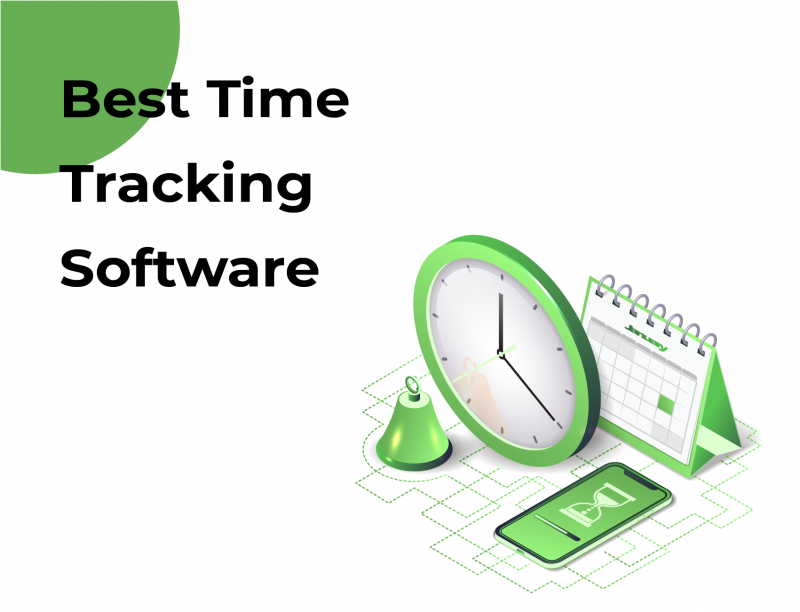The demand for time tracking software is growing, as companies are facing difficulties with managing employee workload during the COVID-19 pandemic. The use of tracking tools lets businesses make the work of remote employees more transparent and simplifies invoicing and payroll.
From an employee’s perspective, a time tracker can be a real disaster. Employees keep forgetting about tracking their time or launching the tracker. Yet, timekeeping software doesn’t have to be a problem.
In this guide, we will introduce you to some good options and help you to choose the right tool for your team.
Before we go any further, let’s define time tracking software for all of us to be on the same page.
Contents
What is time tracking software?
Time tracking software tracks the total time spent by employees on tasks and projects. Simply put, such tools can capture the time spent by your team on work and projects, present these entries with regard to hourly wages, and client billing rates, and help you automate invoicing and payroll management.
Why is time tracking software so important?
There are at least four reasons that make such tools crucial for businesses.
#1. Time keeping applications make tracking and billing precise and transparent.
Time tracking tools are a necessary element of the management puzzle, especially, in professional services and consulting, when the team works according to the Time and Material model. If you bill by the hour, you need to track how much time the team spends on particular tasks and how much of the budget is left.
In short, timekeeping software helps you answer the following key questions:
- Do you keep to the project budget?
- Do you monitor the situation to keep to the budget?
- How much should you invoice?
- How profitable is your project or customer?
With time tracking software, project managers and stakeholders can clearly see how much effort it takes to deliver a project.
#2. Time management software helps project managers to make accurate estimations.
Timesheet software allows project managers to estimate the time and budget required for similar tasks and projects more precisely based on the previous data. So, it is vital to properly report on the time spent on the current project.
#3. Time management software simplest collaboration with remote workers.
The remote workforce has been a trend even before the pandemic. Today many companies are switching to working from home and hence face time-tracking challenges. Time tracking software allows managers to record the time and days worked by each employee in a single tool. Some apps can automatically capture the employee screen to monitor the total time spent on work and other activities.
#4. Time tracker tools make payroll management more efficient.
Payroll managers can look up all the needed information without collaboration with project managers. Time management software keeps the data about the time an employee spends at work, their day-offs, vacation, wages, and incentives, which makes it much easier to calculate payroll.
What can time tracking software do?
The common capabilities of time management software include the following ones:
- track time manually and automatically;
- track billable and non-billable hours per project;
- calculate the number of hours worked by employees per certain period;
- store data, including time entries, contacts, wages, and project information;
- calculate and simplify the management of overtime work;
- provide reports based on the gathered data;
- allow the export of data or generation of invoices right in the app.
Time management software usually lets users edit the automatically tracked time to exclude errors. For example, an employee can leave the timer running and go to lunch, which leads to inaccuracies in the tracked data.
How to choose the best time management software?
As it is true for any tool, there can’t be one best option for every team. Before choosing time keeping applications, it is crucial to understand the workflows of a particular business, how many departments and people are involved in the process.
For sure, there is a common requirement, the ability to work on multiple projects at once and store data securely. Other prerequisites may vary, depending on business needs. In our review, we chose the most vital aspects:
- How easy it is to use the timesheet software. Employees should be able to fill in and get all the data without distraction from their work.
- How smoothly the timekeeping software integrates with third-party tools, such as project management or accounting software.
- How easily the user can make an estimate, compare estimates vs. actuals, and get the reports about the projected and actual figures.
- How quickly and conveniently users can convert figures into reports and create invoices for customers.
Top 10 of time tracking software
With all the above in mind, we analyzed dozens of apps, and came up with a list of 10 time tracker tools. Some of them are free or almost free, some are affordable. The key thing is their usability and ease that makes each of these tools a good assistant in work.
1. Hygger
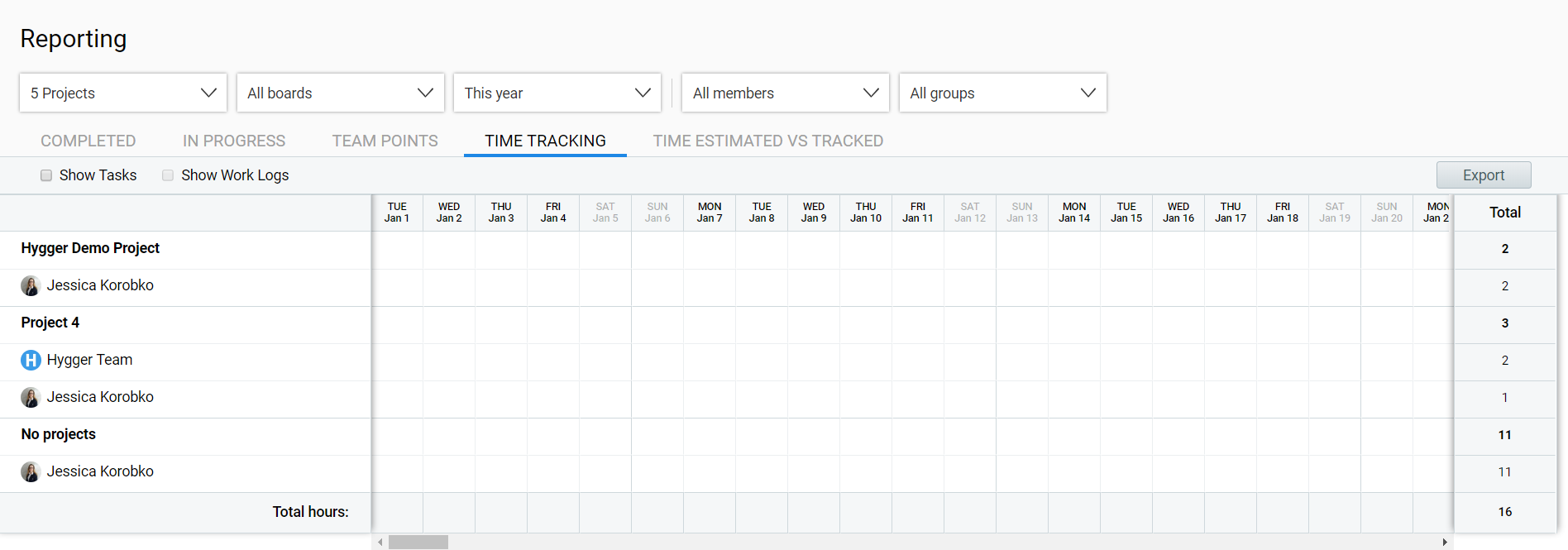
Hygger is a project management and time tracking software that is equipped with powerful Kanban functionality.
Hygger allows users to set tasks, estimate time budget, log work, and add comments to time entries. The tool alerts you when the time budget is exceeded.
Hygger reports give users a convenient view of all the tracked time per employee, team, project, board, and period. You can also quickly analyze the performance of employees by looking at the Time estimated vs. Time tracked report. Thanks to the user roles, employees can see only their personal reports, while the manager can view all the logged work for all projects. All reports can be exported to CSV so that you can use this data for invoicing or billing.
For those who need a timer, Hygger is easily integrated with Harvest, which we will discuss below. Hygger is compatible with Jira, Slack, Intercom, Dropbox, Drive, Bitbucket, iCalendar, and GitHub. The Enterprise edition gives you access to the API so that you can connect Hygger to any third-party tools.
As a project management tool at its core, Hyggers goes beyond time management and includes features needed to organize working processes and balance workload among team members. For example, it includes Kanban boards with Swimlanes, work in progress (WIP) limits, Gantt Charts, and prioritization matrices.
Pricing:
- Standard – $7 per user per month
- Enterprise – $14 per user per month
Hygger has a free version with limited data storage. Paid licenses differ based on the available integrations, SSO, and other features.
Have a look at the Hygger UI.
Let’s check out the pros and cons of the tool.
| Pros | Cons |
|
|
So, Hygger is the right choice for the companies that want to start tracking time and access powerful project management and Kanban functionality at once.
2. Harvest
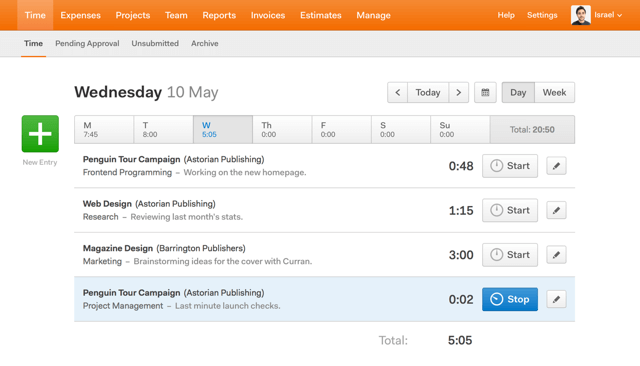
This is one more popular timekeeping software available for Mac, Windows, iOS, Android, and via a Chrome extension. The feature set is quite powerful and lets users manually add entries, give notes, manage entries in bulk, edit mistakes, track billable and non-billable time, and set budget limit alerts.
In addition to time tracking, Harvest can be used for invoicing and collecting payments, however, such functionality is not that strong, and customization can be difficult.
Harvest is compatible with 100+ apps, including Asana, Basecamp, GitHub, Slack, Trello, Stripe, Xero, and others.
Pricing
Harvest is free for a team of 1 member managing up to 2 projects. A 30-day free trial is available for the Pro version as well. The Pro license costs $12 per user per month.
Take a look at the Harvest UI below.
Now, let’s review the pros and cons.
| Pros | Cons |
|
|
Consider Harvest as your time management software if your team works across several devices and needs extensive time tracking capabilities, but has a standalone accounting app.
3. actiTime

actiTIME is a time tracking and work management tool that is available on premises or as a cloud service. actiTIME can be used for tracking time and costs, making assignments and estimates, billing and invoicing.
Users manually enter time while working with the desktop version. The mobile app is equipped with an automatic timer, which is quite handy.
actiTIME allows users to review time track data for any period and generate reports, which is good for productivity management.
Pricing:
- Up to 40 users – $6 per user per month
- 40 to 200 users – $5 per user per month
- 200+ users – price on request
A fully-featured free version is available for small teams of up to 3 users. A company can try other plans for free for 30 days.
This is actiTime in action.
What about the pros and cons?
| Pros | Cons |
|
|
Summing it up, actiTIME suits individuals, small and medium teams that don’t need advanced tracking.
4. RescueTime
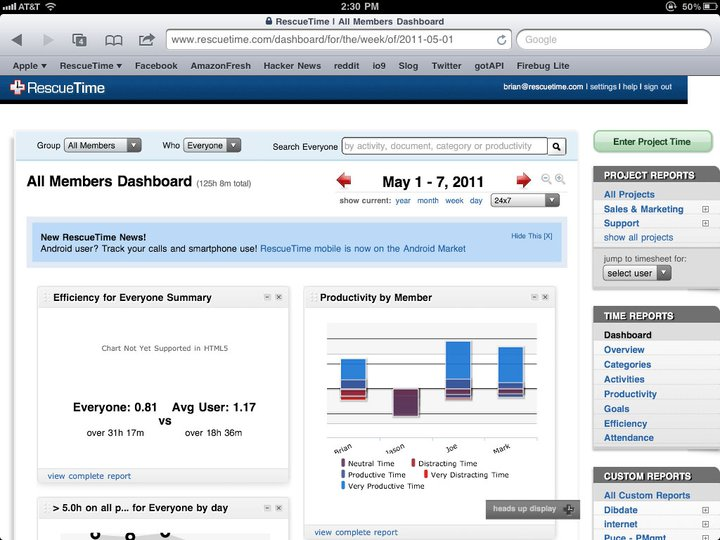
RescueTime is a web-based time management software that focuses on individual productivity. Users train the tool which activities are “productive” and “distracting”, then RescueTime works in the background and automatically tracks the time users spend on particular websites and in apps. At the end of the day or week, users can see a personal productivity report.
The idea of RescueTime is different from other time tracking software. Reports are private and suit only to develop correct time management habits in employees. However, managers can’t see the reports, so RescueTime is not appropriate for team management, billing, and invoicing. RescueTime is compatible with Calendar, Slack, and two popular connective services, If This Then That ( IFTTT) and Zapier.
Pricing
The fees start from $6 per user per month. A free trial is available for 14 days and includes all features.
You can take a look at the RescueTime UI in their demo videos.
Let’s summarize the pros and cons of the tool.
| Pros | Cons |
|
|
RescueTime is time management software for individuals or very responsible teams, in which employees want to find their personal time wasters and improve productivity.
5. TimeCamp
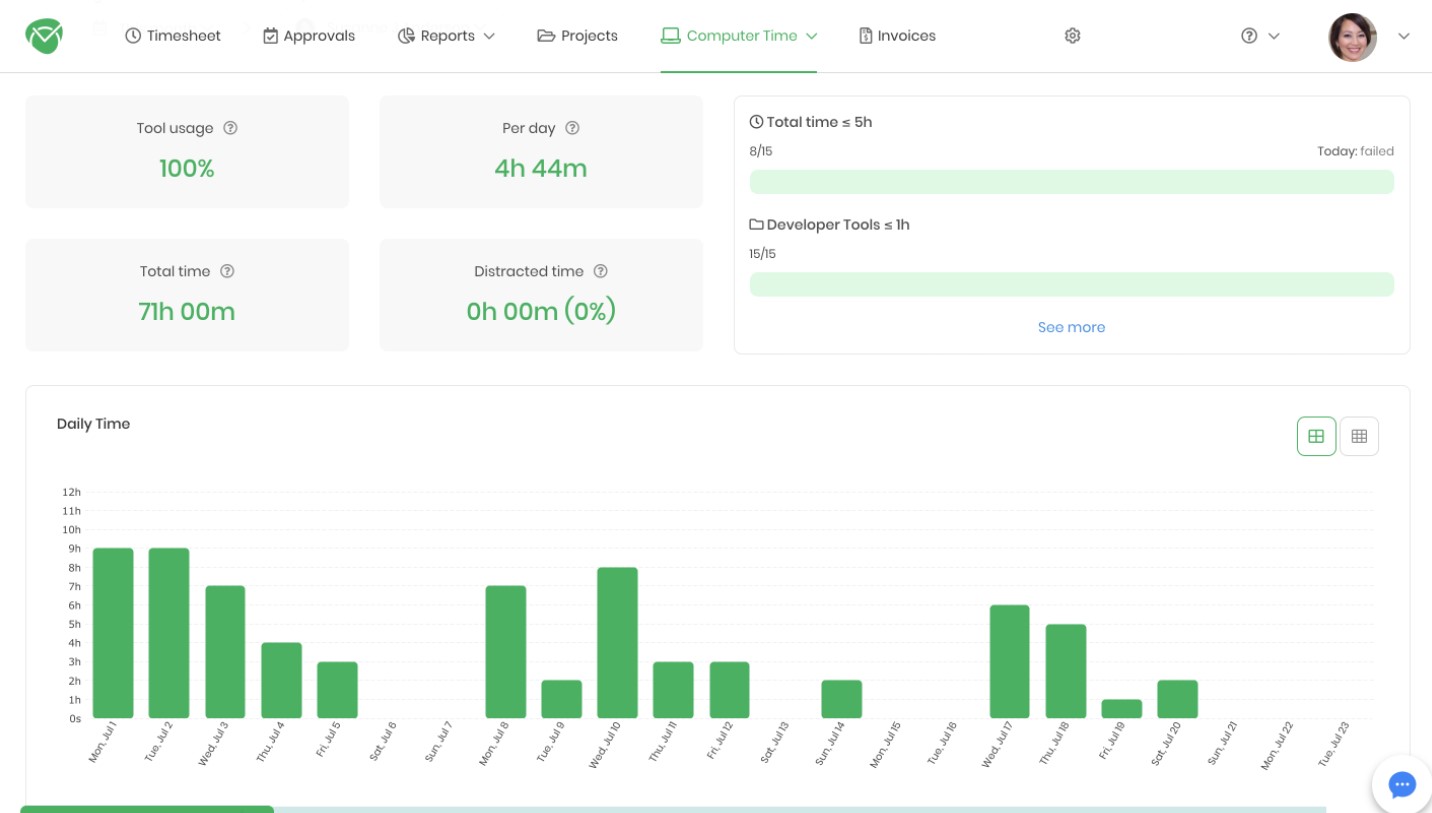
TimeCamp can both foster individual productivity (similar to Rescuetime) and help you manage a team. This time tracking software can work automatically in the background, tracking every minute you spend in apps, on websites, and out of the computer. You get a detailed report with productive activities and time wasters. Managers in their turn can monitor attendance, as well as vacations, leaves, and absences.
TimeCamp allows splitting projects into tasks and assigning tasks to team members. It supports different permissions for users and suits budgeting and invoicing.
Integrations are quite diverse, including Slack, Quickbooks, Trello, Jira, and others.
Pricing:
- Basic – $5.25 per user per month
- Pro – $7.50 per user per month
A fully-featured trial version is available for 14 days. A limited version for 1 user is free.
Have a look at the TimeCamp UI.
Now, let’s get back to the pros and cons.
| Pros | Cons |
|
|
TimeCamp suits individuals and large B2B companies alike.
6. Clockify
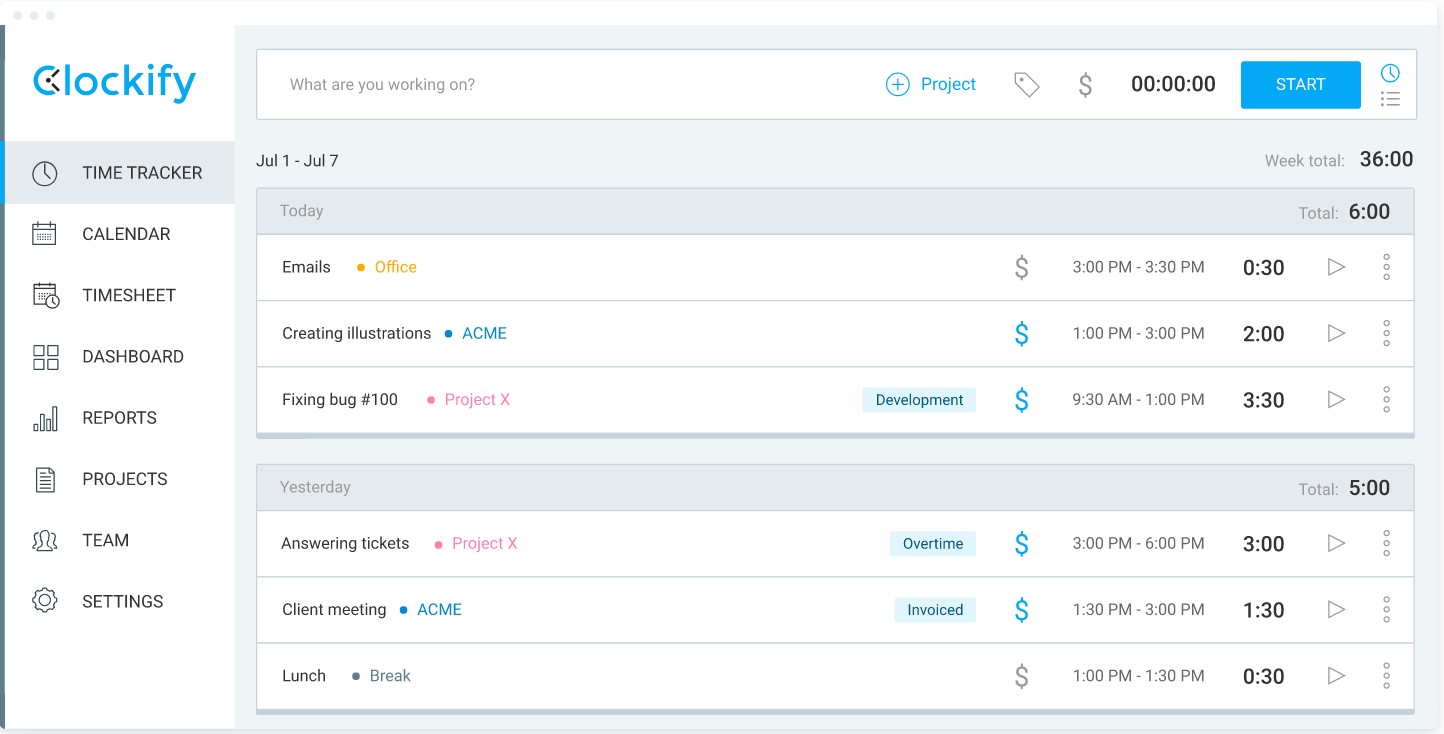
Clockify is a popular and simple timekeeping software that is based on a virtual clock with timesheets. Clockify has an automatic timer and allows manual entry and editing of the info.
Users can add projects, tasks, descriptions, and mark records as billable. Reports are customizable and can be shared with the team and exported as PDF, CSV, and Excel files.
Clockify works via web and on Android and iOS.
Simple tracking features are available for free regardless of the team size. Companies that need more advanced options, such as time rounding, targets, reminders, alerts, bulk edits, automatic lock, single sign-on, time approval, and invoicing, can try one of the paid plans.
Pricing:
- Plus – $9.99 per month
- Premium – $29.99 per month
- Enterprise – $9.99 per user per month
You can look at the Clockify UI in the video below.
Let’s sum up the pros and cons of the tool.
| Pros | Cons |
|
|
Small teams and individuals looking for simple, easy, and budget time keeping applications can try Clockify.
7. Tick
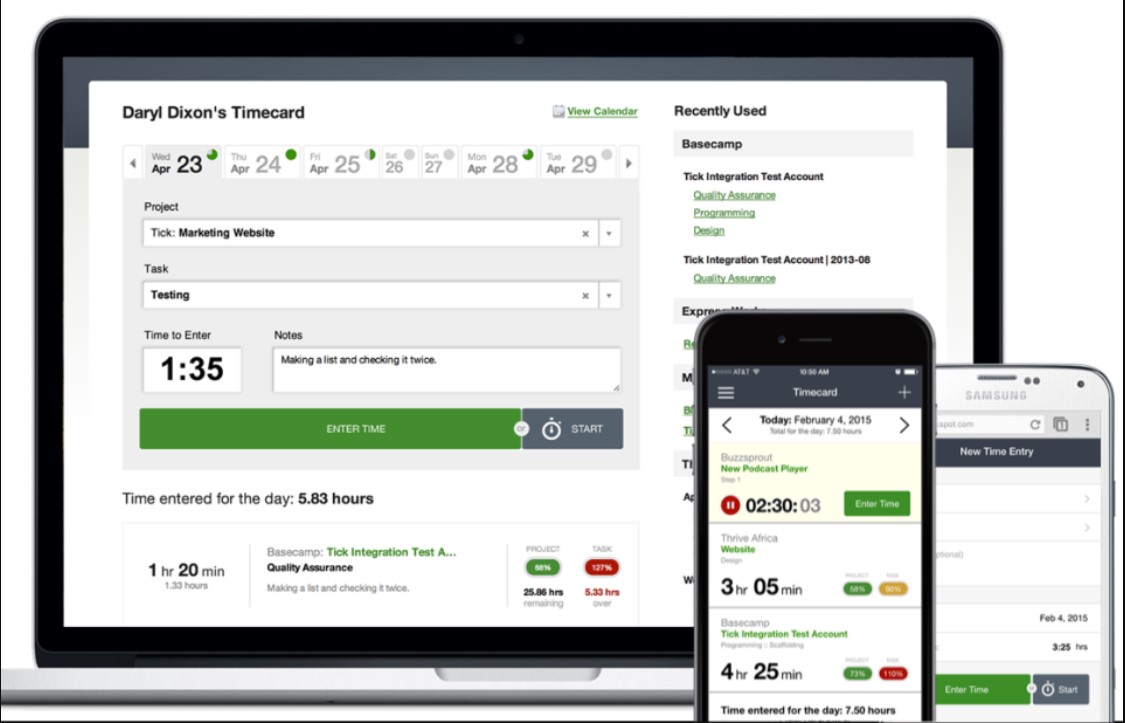
Tick is an easy-to-use time tracking software that is available as a Chrome extension, Android and iOS app. The tool can be used to track time per project and task, add notes to timecards, assign tasks to employees, as well as set and monitor time budgets. Users can automatically generate templates for recurring projects. Tick supports billable and non-billable hours, but can’t be fully used for billing and invoicing.
Tick has a variety of integrations, including Asana, QuickBooks, Zapier, Basecamp, Trello, and others.
Pricing
Tick is priced based on the number of projects, unlike other time management software that is charged per user. A free trial version is available for 30 days.
- 1 project – free
- 10 projects – $19 per month
- 30 projects – $49 per month
- 60 projects – $79 per month
- Unlimited projects – $149 per month
Click this video overview to learn more about Tick and look at it in action.
Let’s check out the pros and cons.
| Pros | Cons |
|
|
Tick is the time management software to choose for the team that values mobility, wants to monitor time budgets, and doesn’t need invoicing or billing in the app.
8. Toggl
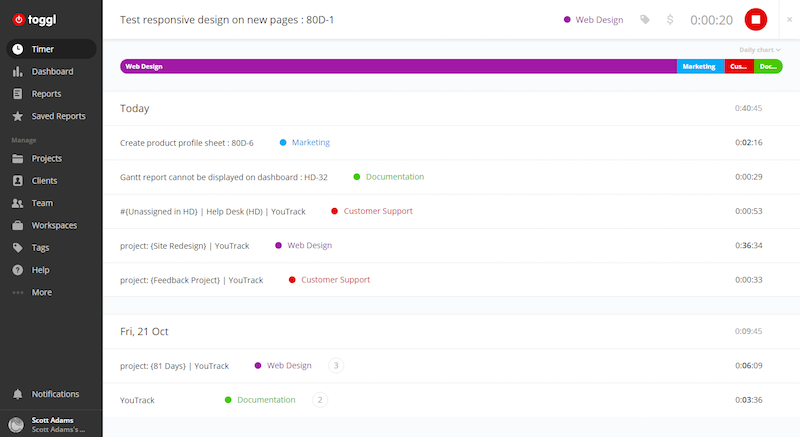
Toggl is a good application for time tracking that is available via web, on Windows, Mac, and Linux, iOS, and Android. It is easy to use and requires no training. Users can either run a timer or add their records manually, specifying the project and task name. There are tags to organize projects.
The mobile app is equipped with calendar features and is rather practical. Advanced reporting features, such as time audits, billable rates, saved reports, XLS export, and scheduling, are available only in Starter and Premium versions.
The simplicity of Toggl is the advantage and its main drawback at the same time. The tool can’t be used for invoicing or scheduling tasks. Toggl is compatible with many third-party tools, including Asana, Google Calendar, GitHub, and Basecamp.
Pricing
Toggl’s plans vary based on their functionality. The free version is available for a team of up to 5 users and is mostly good for logging time. Other plans are more functional:
- Starter – $10 per user per month
- Premium – $20 per user per month
- Enterprise – on request
Take a look at the Toggl UI.
Let’s explore the pros and cons.
| Pros | Cons |
|
|
As employee time tracking software, Toggl will perfectly suit small teams that rely on different devices at work. Larger teams can benefit from scheduled reports, time audits, and dashboards included in the Premium and Enterprise editions.
9. Time Doctor
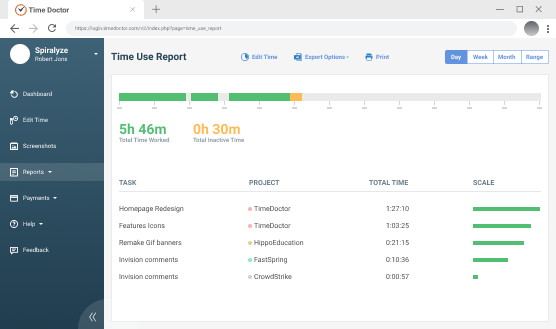
Time Doctor is employee time tracking software that runs on Windows, Mac, iOS, Android, and via the web. Time Doctor is equipped with automatic time tracking, reminders, invoicing, payroll, and reporting features. There are features that go further than tracking, such as client login access and email reports.
The tool can secretly take screenshots and capture videos to show managers what employees are doing at work. This optional feature can be beneficial for tracking and improving productivity and intrusive for employees at the same time.
Time Doctor is intuitive to use and takes little time to install and start using. It syncs with 40 project management, accounting, and collaboration tools, such as Asana, Slack, Jira, GitHub, Basecamp, Salesforce, GoogleApps, and others.
Pricing
Though there is no free version, you can try Time Doсtor for free for 14 days. Paid plans differ by available data storage, the number of users, and functionality.
- Basic – $7 per user per month
- Standard – $10 per user per month
- Premium – $20 per user per month
Below you can see Time Doctor in action.
Let’s sum up the pros and cons of the software.
| Pros | Cons |
|
|
So, Time Doctor can be your time management software if your team works on different platforms and needs advanced automatic tracking (with screen capturing) and invoicing.
10. Timing
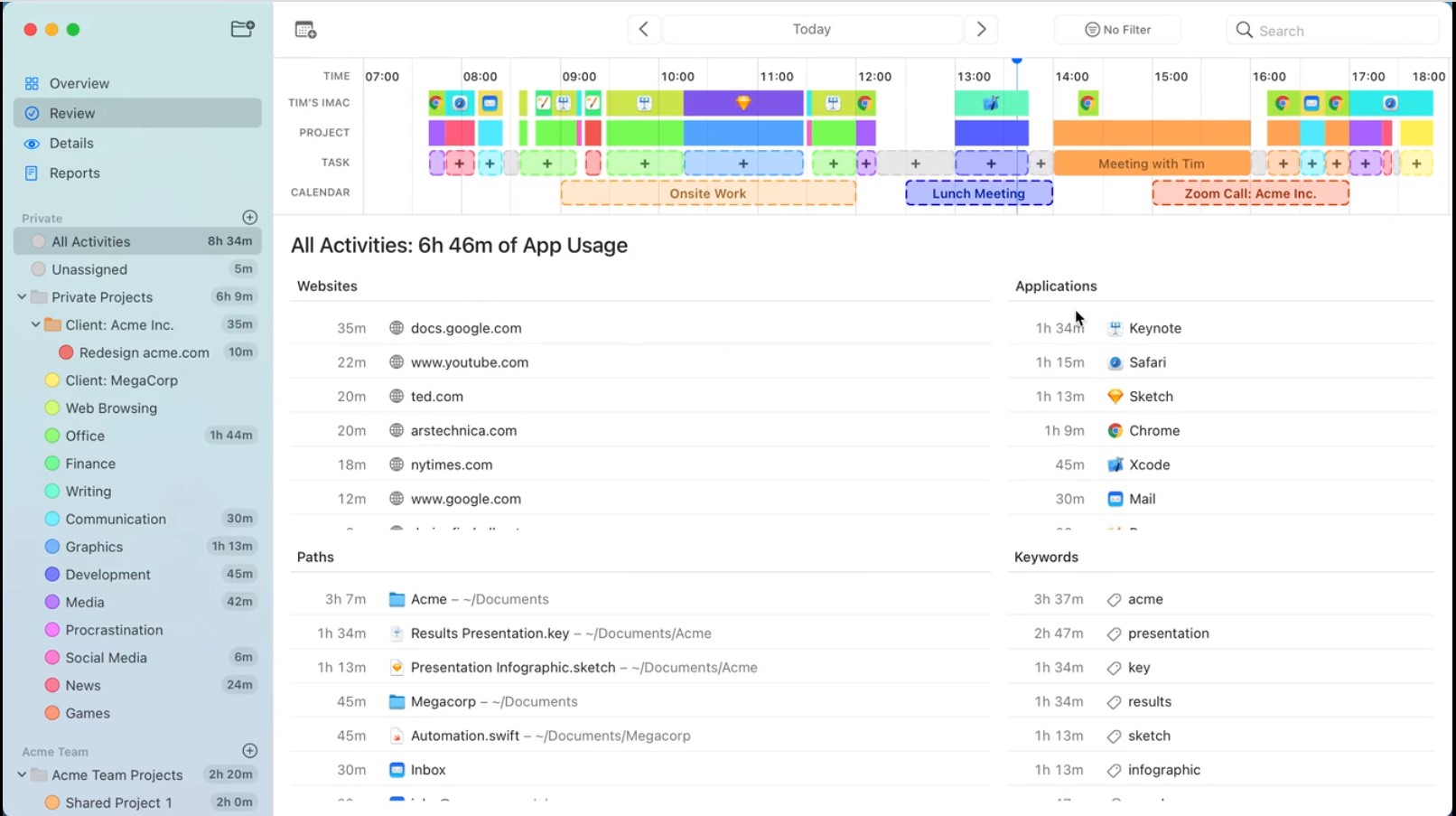
Timing is one more time tracking software that is available for Mac and as a web version. The app can be used for automatic and manual time tracking. Timing works in the background and tracks the time you spend in different apps, which is rather convenient if you have to switch between several tools while working. Users can choose predefined categories or create custom ones so that Timing automatically defines activities as productive or not. The app logs the websites and documents used as well. Reports are quite detailed, customizable, and visually appealing.
To connect to third-party tools, Timing offers access to the web API and Zapier integration.
Users say that Timing has very reliable performance.
Pricing
Timing doesn’t have a free version, but you can try any plan for 14 days. Paid plans differ from each other based on the functionality, available integrations, the number of members on the team, and integrations.
- Professional – $8 per user per month
- Expert – $10 per user per month
- Teams – $17 per user per month
Have a look at the Timing app UI.
Let’s explore the pros and cons of the tool.
|
Pros |
Cons |
|
|
Summing it up, Timing is a reliable app that you will like if you are an individual or a small team, work on Mac or in the browser, and don’t need a mobile version.
Summary of 10 best time tracking software
Let’s briefly review all the tools once again to compare them more closely. Check the table below to learn what you can get for free and how much the licensable time tracker tools cost.
|
Tools |
Free Features |
Price |
| Hygger |
|
|
| Harvest
|
|
|
| actiTIME |
|
|
| RescueTime |
|
|
| TimeCamp |
|
|
| Clockify
|
|
|
| Tick
|
|
|
| Toggl |
|
|
| Time Doctor |
|
|
| Timing |
|
|
Instead of a boring conclusion, we prepared a small bonus for you.
[Bonus]: Time tracking software trends in 2021
Employee time tracking software keeps evolving over time, so quite soon some brand-new capabilities will become a norm.
- Chatbots can assist employees in tracking. More and more businesses are adding chatbots to time management software because they are quite helpful in gathering real-time data about the statuses of tasks and projects. The collected info is sent to timesheets, which excludes the need for employees to manually report on their activity.
- Artificial intelligence will make tracking more efficient. The introduction of AI in time capturing is the next big step. Facial recognition powered by AI can exclude fake clocking in, detect missing hours, and minimize the time required for tracking or even completely automate the process.
More efficient ways of time tracking not only simplify the work of managers but let companies safely introduce flexible shifts.
Do you have some other time tracking tools in mind? Have you used some of the apps listed above? Feel free to share below.





